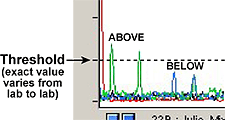Archival Notice
This is an archive page that is no longer being updated. It may contain outdated information and links may no longer function as originally intended.
Home | Glossary | Resources | Help | Contact Us | Course Map
When the quantity of DNA being analyzed is very low, it may be difficult to distinguish true low-level peaks from technical artifacts, including noise. Consequently, most forensic laboratories have established peak-height thresholds for "scoring" alleles. Only if the peak height, expressed in relative fluorescence unit (RFU), exceeds a standard value will it be accepted.
There are no firm rules for establishing threshold values. Each laboratory must set its own as part of its validation procedure. The threshold may be determined experimentally on the basis of observed signal-to-noise ratios, or may be set to a level established by manufacturers or published data. The threshold value will vary depending on many factors including the length of an injection, type of genetic analyzer used and type of STR kit used. Most crime laboratories set analytical thresholds in the range of 50-300 RFU. The lower threshold is a measure of the sensitivity of the procedure. Some laboratories establish both lower and upper thresholds for data interpretation, thereby establishing a window to interpret data.
A laboratory's threshold can be influenced by a variety of factors. For example, there are sensitivity differences between the types of instrumentation (e.g., capillary electrophoresis (CE) instruments and slab-gel instruments) and within any one type of instrument (e.g., between different ABI 310 instruments).
Many laboratories have noted the varying sensitivities of instruments, which tend to be more sensitive and have better resolution than gel-based systems. Some laboratories have established thresholds within their laboratory that vary depending on the sensitivity of the specific instrument.
The upper threshold is crucial when reviewing data from high quantity DNA samples. Samples with high quantities of amplified DNA will have high RFU values that can oversaturate the instrument's ability to detect the sample. This can lead to difficulty in interpretation because an accurate measurement with respect to the peak heights and/or areas may not be obtained. This can be especially problematic when working with mixed samples.
Additional Online Courses
- What Every First Responding Officer Should Know About DNA Evidence
- Collecting DNA Evidence at Property Crime Scenes
- DNA – A Prosecutor’s Practice Notebook
- Crime Scene and DNA Basics
- Laboratory Safety Programs
- DNA Amplification
- Population Genetics and Statistics
- Non-STR DNA Markers: SNPs, Y-STRs, LCN and mtDNA
- Firearms Examiner Training
- Forensic DNA Education for Law Enforcement Decisionmakers
- What Every Investigator and Evidence Technician Should Know About DNA Evidence
- Principles of Forensic DNA for Officers of the Court
- Law 101: Legal Guide for the Forensic Expert
- Laboratory Orientation and Testing of Body Fluids and Tissues
- DNA Extraction and Quantitation
- STR Data Analysis and Interpretation
- Communication Skills, Report Writing, and Courtroom Testimony
- Español for Law Enforcement
- Amplified DNA Product Separation for Forensic Analysts


